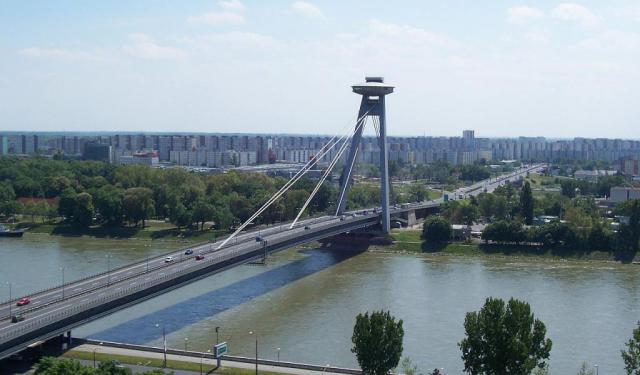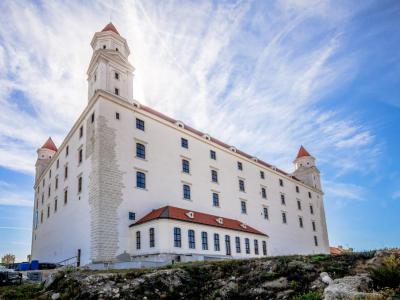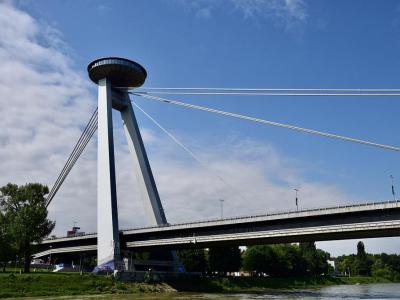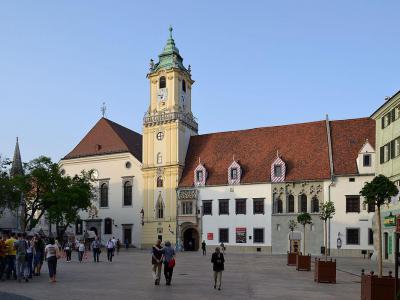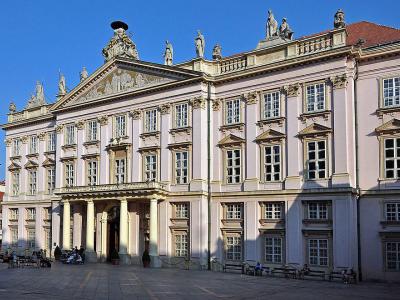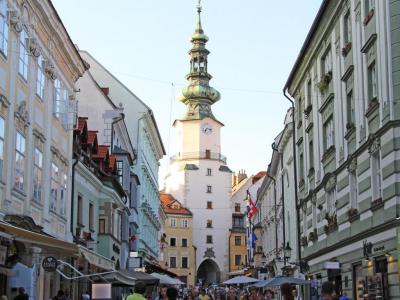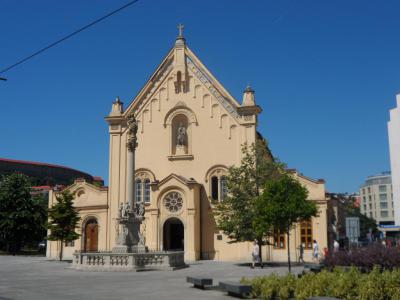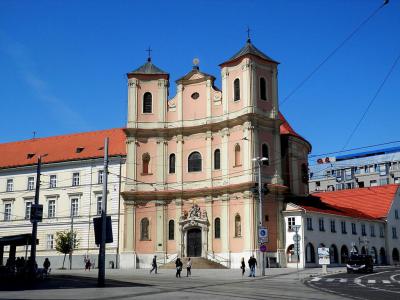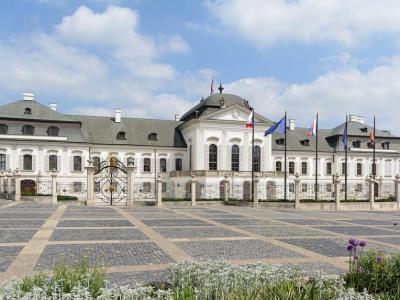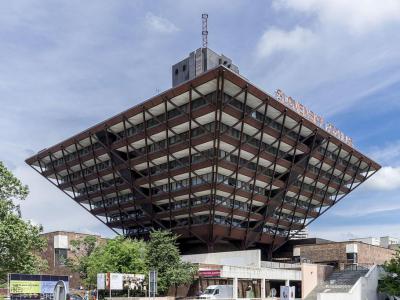Bratislava Architectural Jewels (Self Guided), Bratislava
For centuries, Bratislava has been influenced by European art, culture, and architecture. The juxtaposition of styles here creates a captivating fabric where centuries-old Gothic and Baroque structures harmonize with sleek, modern designs.
The majestic Bratislava Castle, perched on a hill overlooking the Danube River since the 9th century, has seen many renovations over the years. Today, it showcases a mix of medieval and Renaissance styles.
Another iconic sight is the New Bridge. Crowned with the UFO Observation Deck, this modern marvel offers panoramic views of the city and the surrounding landscape. In contrast, the Old Town Hall exudes medieval charm with its Gothic architecture and intricate details.
The Primate's Palace is a grand piece of Neoclassical architecture, renowned among other elements for its stunning Hall of Mirrors. Meanwhile, Michael's Tower and Street beckon with their quaint cobblestone pathways and historic ambiance.
Religious architecture also flourishes in Bratislava, with notable landmarks like the Capuchin Church and the Trinitarian Church displaying elaborate Baroque designs and ornate interiors.
For a glimpse into Slovakia's political history, check out the Grassalkovich Palace, the official residence of the country's president, surrounded by lush gardens and elegant facades.
In the realm of modern architecture, the Slovak Radio Building stands out with its avant-garde design, reflecting the city's dynamic spirit and forward-thinking ethos.
In Bratislava, where ancient fortresses, medieval streets, and contemporary structures converge to weave a tapestry of beauty and heritage, exploring architectural jewels can be truly captivating. Our self-guided tour is an invitation to unravel stories hidden within their walls, wander through the centuries-old walkways, ascend to dizzying heights for breathtaking vistas, and immerse yourself in the charm of this enchanting city.
The majestic Bratislava Castle, perched on a hill overlooking the Danube River since the 9th century, has seen many renovations over the years. Today, it showcases a mix of medieval and Renaissance styles.
Another iconic sight is the New Bridge. Crowned with the UFO Observation Deck, this modern marvel offers panoramic views of the city and the surrounding landscape. In contrast, the Old Town Hall exudes medieval charm with its Gothic architecture and intricate details.
The Primate's Palace is a grand piece of Neoclassical architecture, renowned among other elements for its stunning Hall of Mirrors. Meanwhile, Michael's Tower and Street beckon with their quaint cobblestone pathways and historic ambiance.
Religious architecture also flourishes in Bratislava, with notable landmarks like the Capuchin Church and the Trinitarian Church displaying elaborate Baroque designs and ornate interiors.
For a glimpse into Slovakia's political history, check out the Grassalkovich Palace, the official residence of the country's president, surrounded by lush gardens and elegant facades.
In the realm of modern architecture, the Slovak Radio Building stands out with its avant-garde design, reflecting the city's dynamic spirit and forward-thinking ethos.
In Bratislava, where ancient fortresses, medieval streets, and contemporary structures converge to weave a tapestry of beauty and heritage, exploring architectural jewels can be truly captivating. Our self-guided tour is an invitation to unravel stories hidden within their walls, wander through the centuries-old walkways, ascend to dizzying heights for breathtaking vistas, and immerse yourself in the charm of this enchanting city.
How it works: Download the app "GPSmyCity: Walks in 1K+ Cities" from Apple App Store or Google Play Store to your mobile phone or tablet. The app turns your mobile device into a personal tour guide and its built-in GPS navigation functions guide you from one tour stop to next. The app works offline, so no data plan is needed when traveling abroad.
Bratislava Architectural Jewels Map
Guide Name: Bratislava Architectural Jewels
Guide Location: Slovakia » Bratislava (See other walking tours in Bratislava)
Guide Type: Self-guided Walking Tour (Sightseeing)
# of Attractions: 9
Tour Duration: 2 Hour(s)
Travel Distance: 3.5 Km or 2.2 Miles
Author: hollyg
Sight(s) Featured in This Guide:
Guide Location: Slovakia » Bratislava (See other walking tours in Bratislava)
Guide Type: Self-guided Walking Tour (Sightseeing)
# of Attractions: 9
Tour Duration: 2 Hour(s)
Travel Distance: 3.5 Km or 2.2 Miles
Author: hollyg
Sight(s) Featured in This Guide:
- Bratislava Castle
- New Bridge and UFO Observation Deck
- Old Town Hall
- Primate's Palace
- Michael's Tower and Street
- Capuchin Church
- Trinitarian Church of Bratislava
- Grassalkovich Palace
- Slovak Radio Building
1) Bratislava Castle (must see)
The imposing Bratislava Castle is the most conspicuous landmark in the town of Bratislava. It stands on an isolated rocky hill above the town, and had been built and rebuilt continuously throughout the 9th-18th centuries.
The site of the castle has been of strategic importance for most of the area's history. It is located roughly in the center of Europe. Still, more importantly, it is along the route between the Carpathians and the Alps at a convenient crossing point of the river Danube.
The hill and surrounding area have hosted settlements since before the early Iron Age. Evidence suggests that the first settlements here started around 3,500 BC. In those early centuries, the hill was used as an acropolis for the surrounding town.
Archeological evidence shows a history of Celt and Roman occupation through 500 AD. The current structure was begun in the 10th century but worked lagged over the years. As the need for defense increased for the Kingdom of Hungary, the castle was added on to.
The Kingdom was abolished in 1781, and the castle was more or less dismantled and abandoned. The structures were used as a seminary and military barracks for some time during the 19th century. By the middle part of the 20th century, the castle was in ruins.
A massive restoration effort was begun in 1957 and completed in 1968. The 1968 Federation Law, which formed the Czech Socialist Republic and the Slovak Socialist Republic, was signed in the castle. Many years later, the constitution of now independent Slovakia was also signed in the castle's Knights Hall.
The castle is beautifully restored and houses exhibitions from the Slovak National Museum. Even if you choose not to visit the museum and interior rooms, walking around the castle grounds and enjoying the views of the city and the Danube is not to be missed.
The site of the castle has been of strategic importance for most of the area's history. It is located roughly in the center of Europe. Still, more importantly, it is along the route between the Carpathians and the Alps at a convenient crossing point of the river Danube.
The hill and surrounding area have hosted settlements since before the early Iron Age. Evidence suggests that the first settlements here started around 3,500 BC. In those early centuries, the hill was used as an acropolis for the surrounding town.
Archeological evidence shows a history of Celt and Roman occupation through 500 AD. The current structure was begun in the 10th century but worked lagged over the years. As the need for defense increased for the Kingdom of Hungary, the castle was added on to.
The Kingdom was abolished in 1781, and the castle was more or less dismantled and abandoned. The structures were used as a seminary and military barracks for some time during the 19th century. By the middle part of the 20th century, the castle was in ruins.
A massive restoration effort was begun in 1957 and completed in 1968. The 1968 Federation Law, which formed the Czech Socialist Republic and the Slovak Socialist Republic, was signed in the castle. Many years later, the constitution of now independent Slovakia was also signed in the castle's Knights Hall.
The castle is beautifully restored and houses exhibitions from the Slovak National Museum. Even if you choose not to visit the museum and interior rooms, walking around the castle grounds and enjoying the views of the city and the Danube is not to be missed.
2) New Bridge and UFO Observation Deck (must see)
One of the most iconic features of modern-day Bratislava is the Novy Most, or "New Bridge." This modern thoroughfare connects the two halves of the city separated by the river Danube. Since 2012, the official name of the bridge was changed to "Bridge of the Slovak National Uprising" to commemorate the Slovak National Uprising against Nazi during World War II, but locals prefer to call it "UFO Bridge" for its UFO-shaped observation desk at the top.
The Novy Most was built between 1967 and 1972. The total length of the bridge is 1,413 feet or 430 meters. It is an asymmetrical cable-stayed bridge made of steel. It is the world's longest bridge that has only one pylon with one cable-stayed plane. One of the best features of the bridge is that the lower levels are reserved for pedestrian and bicycle traffic only.
Of course, the most notable feature of the Novy Most is the UFO-shaped restaurant and observation deck. The building is mounted on top of the bridge's 278-foot-tall (84.6-meter) pylon.
While the restaurant serves some delicious Slovak and international cuisine, the real lure of the UFO is the view of the city and river from above.
The Novy Most was built between 1967 and 1972. The total length of the bridge is 1,413 feet or 430 meters. It is an asymmetrical cable-stayed bridge made of steel. It is the world's longest bridge that has only one pylon with one cable-stayed plane. One of the best features of the bridge is that the lower levels are reserved for pedestrian and bicycle traffic only.
Of course, the most notable feature of the Novy Most is the UFO-shaped restaurant and observation deck. The building is mounted on top of the bridge's 278-foot-tall (84.6-meter) pylon.
While the restaurant serves some delicious Slovak and international cuisine, the real lure of the UFO is the view of the city and river from above.
3) Old Town Hall
The Old Town Hall of Bratislava is an excellent example of Gothic architecture. Originally constructed in the 14th century, with the tower dating back from approximately 1370, this is one of the oldest stone buildings in the Slovakian capital. It was originally designed to accommodate soldiers guarding the fortress surrounding the medieval town.
Presently, the Old Town Hall represents a complex of buildings created through merger of several adjacent townhouses, namely: Jacobus' house with a tower, Pawer's house, Unger's house, and the Apponyi palace. Over the ages, the property had undergone numerous reconstructions and served different purposes: as a prison, mint, market, municipal archive, and arsenal depository, until it finally became a town hall in the 15th century. In this capacity it had served until the late 19th century.
During the Renaissance period, the complex passed through various transformations, including those after being damaged by an earthquake and then fire.
Today, it houses the Bratislava City Museum, featuring a collection of historic artifacts: cannonballs; dungeons with instruments of torture; antique weaponry and armour; as well as paintings and miniatures. One of the cannonballs, the one embedded in the tower wall, is of a particular interest to visitors. It has been there since 1809, resulted from the bombardment of the city by the invading Napoleonic army.
In the summer, the courtyard plays host to musical concerts. In the attic of the Apponyi Palace there is a Study Depository of Glass and Ceramics. The beautifully-tiled roof of the building is one of the city's most recognizable landmarks. The top of the Old Town Hall tower is open to visitors, as part of the Bratislava City Museum exhibition, offering a round view of the old part of Bratislava and its environs.
Presently, the Old Town Hall represents a complex of buildings created through merger of several adjacent townhouses, namely: Jacobus' house with a tower, Pawer's house, Unger's house, and the Apponyi palace. Over the ages, the property had undergone numerous reconstructions and served different purposes: as a prison, mint, market, municipal archive, and arsenal depository, until it finally became a town hall in the 15th century. In this capacity it had served until the late 19th century.
During the Renaissance period, the complex passed through various transformations, including those after being damaged by an earthquake and then fire.
Today, it houses the Bratislava City Museum, featuring a collection of historic artifacts: cannonballs; dungeons with instruments of torture; antique weaponry and armour; as well as paintings and miniatures. One of the cannonballs, the one embedded in the tower wall, is of a particular interest to visitors. It has been there since 1809, resulted from the bombardment of the city by the invading Napoleonic army.
In the summer, the courtyard plays host to musical concerts. In the attic of the Apponyi Palace there is a Study Depository of Glass and Ceramics. The beautifully-tiled roof of the building is one of the city's most recognizable landmarks. The top of the Old Town Hall tower is open to visitors, as part of the Bratislava City Museum exhibition, offering a round view of the old part of Bratislava and its environs.
4) Primate's Palace
Today this impressive baroque building is the home of the Mayor of Bratislava, but there is much more history to uncover here.
The Primate's Palace was built from 1777 to 1781 and was designed by Melchoir Hefele. At one time, the palace was home to the primary bishops.
The palace's greatest claim to fame was that it served as a backdrop for signing the fourth Peace of Pressburg in 1805. This document, signed in the building's famous Hall of Mirrors, dissolved the Holy Roman Empire. A bust of Emperor Francis II, the last Roman Emperor, stands near the hall to commemorate the event.
The city purchased the palace in 1903 and began an extensive reconstruction project. During the work, 17th-century tapestries were found behind walls.
For a brief time, the palace was home to the President of Slovakia before his permanent residence was built at Grassalkovich Palace.
The palace is open for tours. You can even see the famous Hall of Mirrors, now used for Bratislava City Council meetings.
The Primate's Palace was built from 1777 to 1781 and was designed by Melchoir Hefele. At one time, the palace was home to the primary bishops.
The palace's greatest claim to fame was that it served as a backdrop for signing the fourth Peace of Pressburg in 1805. This document, signed in the building's famous Hall of Mirrors, dissolved the Holy Roman Empire. A bust of Emperor Francis II, the last Roman Emperor, stands near the hall to commemorate the event.
The city purchased the palace in 1903 and began an extensive reconstruction project. During the work, 17th-century tapestries were found behind walls.
For a brief time, the palace was home to the President of Slovakia before his permanent residence was built at Grassalkovich Palace.
The palace is open for tours. You can even see the famous Hall of Mirrors, now used for Bratislava City Council meetings.
5) Michael's Tower and Street (must see)
The only surviving gate from the city's medieval walls lies at the end of Michael's Street. Michael's Gate (Michalska Brana) was built around 1300 and once stood with three others leading into town. It is one of the oldest buildings in town.
The tower's baroque exterior is a result of reconstruction works carried out in the 1750s. The statue of Saint Michael and the Dragon was placed at the top during this time.
The gate got its name as the Church of Saint Michael stood just outside the city walls here.
At one point, the city was surrounded by medieval fortifications. Entrance to town was only possible through the four gates, all of which were guarded and fortified. The other gates, now demolished, were the Laurens Gate, Fisherman's Gate on the river Danube, and Vydrica Gate.
At its height, the gate was part of a much larger system of fortifications. They included two rings of city walls, two bastions, a barbican, and a bridge over a moat. The barbican is still present and today has been built into houses. The original bridge over the moat was replaced by a stone one in 1727. Some of the moat is also still visible.
The view from the top of the seven-floor, 51-meter tall tower is spectacular. There is no better place from which to view the old town of Bratislava. To get in the tower, enter through the Museum of Arms. The museum contains excellent exhibits about the fortifications and the history of the city.
The street leading from the Michael's Gate, Michael's Street, is lined with shops and attractions. In addition to the Arms Museum, you'll also find the Pharmacy Museum nearby in a very old shop building. There are also bars, cafes, and restaurants lining the street.
The tower's baroque exterior is a result of reconstruction works carried out in the 1750s. The statue of Saint Michael and the Dragon was placed at the top during this time.
The gate got its name as the Church of Saint Michael stood just outside the city walls here.
At one point, the city was surrounded by medieval fortifications. Entrance to town was only possible through the four gates, all of which were guarded and fortified. The other gates, now demolished, were the Laurens Gate, Fisherman's Gate on the river Danube, and Vydrica Gate.
At its height, the gate was part of a much larger system of fortifications. They included two rings of city walls, two bastions, a barbican, and a bridge over a moat. The barbican is still present and today has been built into houses. The original bridge over the moat was replaced by a stone one in 1727. Some of the moat is also still visible.
The view from the top of the seven-floor, 51-meter tall tower is spectacular. There is no better place from which to view the old town of Bratislava. To get in the tower, enter through the Museum of Arms. The museum contains excellent exhibits about the fortifications and the history of the city.
The street leading from the Michael's Gate, Michael's Street, is lined with shops and attractions. In addition to the Arms Museum, you'll also find the Pharmacy Museum nearby in a very old shop building. There are also bars, cafes, and restaurants lining the street.
6) Capuchin Church
The Capuchin Church in Bratislava is a notable historical and architectural gem nestled in the heart of the country's capital. This modest church, dedicated to Saint Stephen of Hungary, stands as a testament to the Capuchin order's expansion into the Slavic region during the early 18th century. Construction began in 1711, marking it as one of the first Capuchin temples in Central Europe. The church originally served as the center of a new parish, gradually earning its reputation as one of Bratislava's most important religious buildings.
Architecturally, the Capuchin Church is an example of the Baroque style, characterized by its tall, angular facade and somewhat low ceilings compared to larger cathedrals. Despite its size, the church features long corridors and tall towers, typical of the solemn and reflective aesthetic of Catholic worship spaces. At the front, a robust column showcases a sculpture of the Virgin Mary, and a memorial statue of King Stephen further enriches the church's entrance.
Inside, the church's white walls and large windows create a bright and welcoming atmosphere, reflecting natural light that accentuates its modest interior. The church houses several religious artworks, including frescoes, statuettes, and wood carvings, primarily focused on religious themes. Notably, outside the church, a plaque commemorates the victims of the plague, adding a historical layer to its religious significance.
Today, the Capuchin Church remains a cherished historical monument in Bratislava, offering a quiet, simple space where visitors can reflect and appreciate its cultural and religious heritage. Its unassuming presence in a bustling metropolis makes it a must-see for anyone exploring the architectural and historical landscapes of Slovakia.
Architecturally, the Capuchin Church is an example of the Baroque style, characterized by its tall, angular facade and somewhat low ceilings compared to larger cathedrals. Despite its size, the church features long corridors and tall towers, typical of the solemn and reflective aesthetic of Catholic worship spaces. At the front, a robust column showcases a sculpture of the Virgin Mary, and a memorial statue of King Stephen further enriches the church's entrance.
Inside, the church's white walls and large windows create a bright and welcoming atmosphere, reflecting natural light that accentuates its modest interior. The church houses several religious artworks, including frescoes, statuettes, and wood carvings, primarily focused on religious themes. Notably, outside the church, a plaque commemorates the victims of the plague, adding a historical layer to its religious significance.
Today, the Capuchin Church remains a cherished historical monument in Bratislava, offering a quiet, simple space where visitors can reflect and appreciate its cultural and religious heritage. Its unassuming presence in a bustling metropolis makes it a must-see for anyone exploring the architectural and historical landscapes of Slovakia.
7) Trinitarian Church of Bratislava
The Trinitarian Church of Bratislava is also known as the Church of Saint John of Matha and Saint Felix of Valois. Located in the Old Town of Bratislava, the church is chockfull of fantastic Baroque features. The structure was erected on the original location of the first Saint Michael’s Church in 1717, after almost 200 years following the destruction of the Saint Michael’s settlement during the Ottoman wars.
Many of the components found in the design of the building were influenced by features of the Saint Peter’s Church in Vienna, the sister city of Bratislava. With its awe-inspiring vaulting and unbelievable frescos, this is categorically a must-see for those who appreciate architecture. The altar was manufactured by A.G. Bussi. The main feature of the construction is the altarpiece showing Saint John of Matha and Saint Felix of Valois ransoming prisoners, while the statues of Saint Agnes and Saint Catherine flank the altar.
Over the years, the great hall of the church has played host to various prominent composers who held concerts for the public, including Johannes Brahms and Franz Liszt. The building has served as a secular and sacred facility with everything from church services to political events being facilitated within its walls.
Many of the components found in the design of the building were influenced by features of the Saint Peter’s Church in Vienna, the sister city of Bratislava. With its awe-inspiring vaulting and unbelievable frescos, this is categorically a must-see for those who appreciate architecture. The altar was manufactured by A.G. Bussi. The main feature of the construction is the altarpiece showing Saint John of Matha and Saint Felix of Valois ransoming prisoners, while the statues of Saint Agnes and Saint Catherine flank the altar.
Over the years, the great hall of the church has played host to various prominent composers who held concerts for the public, including Johannes Brahms and Franz Liszt. The building has served as a secular and sacred facility with everything from church services to political events being facilitated within its walls.
8) Grassalkovich Palace
Grassalkovich Palace, located in Bratislava, is a significant architectural and historical landmark. This Rococo-late Baroque summer palace, completed in 1760 by architect András Mayerhoffer, was originally constructed for the Hungarian aristocrat Antal Grassalkovich, a confidant of Maria Theresa and a prominent figure in the Royal Hungarian Chamber. Positioned on Hodžovo námestie and near the Summer Archbishop's Palace, it features an elegant French garden.
The palace became a vibrant center of Baroque music, hosting premieres of Joseph Haydn's compositions, thanks to Grassalkovich’s close ties with the Habsburg royal court. It was also the scene of various significant social events, including balls attended by members of the royal family.
Following the end of the Austro-Hungarian Empire, the palace underwent several transformations. It served as the residence of Jozef Tiso, leader of the fascist Slovak Republic during World War II, and later as an administrative building during the Communist era. Notably, it was repurposed as the "Klement Gottwald House of Pioneers and Youth," which led to considerable wear and tear from its use by schoolchildren.
After the fall of Communism in 1989, the palace was extensively restored under the supervision of Emília Kováčová, Slovakia’s inaugural First Lady. Since 1996, it has served as the official residence of the President of Slovakia. Today, its once-private gardens are open to the public as a park, featuring a statue of the composer Jan Nepomuk Hummel, enhancing its cultural and historical heritage for visitors and residents alike.
The palace became a vibrant center of Baroque music, hosting premieres of Joseph Haydn's compositions, thanks to Grassalkovich’s close ties with the Habsburg royal court. It was also the scene of various significant social events, including balls attended by members of the royal family.
Following the end of the Austro-Hungarian Empire, the palace underwent several transformations. It served as the residence of Jozef Tiso, leader of the fascist Slovak Republic during World War II, and later as an administrative building during the Communist era. Notably, it was repurposed as the "Klement Gottwald House of Pioneers and Youth," which led to considerable wear and tear from its use by schoolchildren.
After the fall of Communism in 1989, the palace was extensively restored under the supervision of Emília Kováčová, Slovakia’s inaugural First Lady. Since 1996, it has served as the official residence of the President of Slovakia. Today, its once-private gardens are open to the public as a park, featuring a statue of the composer Jan Nepomuk Hummel, enhancing its cultural and historical heritage for visitors and residents alike.
9) Slovak Radio Building
The Slovak Radio Building in Bratislava is an architectural icon known for its distinctive upside-down pyramid shape, earning it the local nickname "Radio Diamant." Designed by architects Štefan Svetko, Štefan Ďurkovič, and Barnabáš Kissling, the building was completed in 1983 after beginning construction in 1967. Standing at 80 meters tall, it features a 522-seat concert hall equipped with a large concert organ. The building first tested broadcasting in 1984 and commenced regular broadcasting on March 27, 1985, serving as the headquarters for Radio and Television of Slovakia (RTVS).
Constructed during a period when socialist realism was the mandated architectural style in Czechoslovakia, the Slovak Radio Building represents a break from the norm. The architects were allowed some freedom to innovate, which led them to diverge from the typical high-rise designs of the time that featured a low block topped by a tall office tower. Instead, their design emphasized expressiveness and uniqueness, with Štefan Svetko famously describing the building as a "temple of word and music."
This building was among the first major constructions in Slovakia to use a steel frame rather than the then-standard prefabricated concrete panels. This choice, while novel, introduced challenges due to the limited local experience with steel construction at the time.
Originally selected through a design competition in 1963 that was won by Miloš Chorvát, the investor ultimately chose the second-place design by Svetko, Ďurkovič, and Kissling. The building's location, which was peripheral at the time of its conception, is now considered part of the broader center of Bratislava, marking it as a significant landmark within the city's architectural landscape.
Constructed during a period when socialist realism was the mandated architectural style in Czechoslovakia, the Slovak Radio Building represents a break from the norm. The architects were allowed some freedom to innovate, which led them to diverge from the typical high-rise designs of the time that featured a low block topped by a tall office tower. Instead, their design emphasized expressiveness and uniqueness, with Štefan Svetko famously describing the building as a "temple of word and music."
This building was among the first major constructions in Slovakia to use a steel frame rather than the then-standard prefabricated concrete panels. This choice, while novel, introduced challenges due to the limited local experience with steel construction at the time.
Originally selected through a design competition in 1963 that was won by Miloš Chorvát, the investor ultimately chose the second-place design by Svetko, Ďurkovič, and Kissling. The building's location, which was peripheral at the time of its conception, is now considered part of the broader center of Bratislava, marking it as a significant landmark within the city's architectural landscape.
Walking Tours in Bratislava, Slovakia
Create Your Own Walk in Bratislava
Creating your own self-guided walk in Bratislava is easy and fun. Choose the city attractions that you want to see and a walk route map will be created just for you. You can even set your hotel as the start point of the walk.
Historical Churches
Although somewhat modest in terms of sights, compared to the neighboring Vienna or Prague, the capital of Slovakia, Bratislava, does have a collection of historical churches that may be of interest to lovers of religious architecture.
Perhaps one of the most prominent landmarks in this area is Saint Martin's Cathedral. Dating back to the mid-15th century, this Gothic-style temple with a... view more
Tour Duration: 2 Hour(s)
Travel Distance: 2.5 Km or 1.6 Miles
Perhaps one of the most prominent landmarks in this area is Saint Martin's Cathedral. Dating back to the mid-15th century, this Gothic-style temple with a... view more
Tour Duration: 2 Hour(s)
Travel Distance: 2.5 Km or 1.6 Miles
Bratislava Old Town
The cityscape of Bratislava is characterized by medieval and other ancient buildings, the lion's share of which are concentrated in the Old Town. The special charm of the city's old quarter never ceases to amaze and is bound to leave anyone absolutely dazzled with its beauty.
The Old Town is indeed Bratislava's historic center, and as such, houses many historic monuments and... view more
Tour Duration: 2 Hour(s)
Travel Distance: 1.2 Km or 0.7 Miles
The Old Town is indeed Bratislava's historic center, and as such, houses many historic monuments and... view more
Tour Duration: 2 Hour(s)
Travel Distance: 1.2 Km or 0.7 Miles
Bratislava Introduction Walking Tour
The capital of Slovakia, Bratislava, is a lovely city straddling the river Danube near the convergence of the Austrian and Hungarian borders. Such closeness had its toll on the city's long and often tumultuous history, in which the Austrians, Croats, Czechs, Germans, Hungarians, Jews, Serbs and Slovaks played their role.
Formerly part of the Hungarian Kingdom, from 1536 to 1783 it was the... view more
Tour Duration: 2 Hour(s)
Travel Distance: 3.4 Km or 2.1 Miles
Formerly part of the Hungarian Kingdom, from 1536 to 1783 it was the... view more
Tour Duration: 2 Hour(s)
Travel Distance: 3.4 Km or 2.1 Miles
The Most Popular Cities
/ view all
